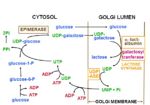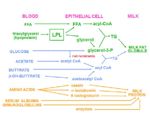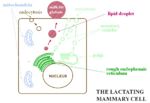Milk Composition and Biosynthesis- Anatomy & Physiology
Milk Composition
- Milk separates into two phases:
1. Water Phase: Comprises 70-90% of the milk to provide fluid to the neonate and a medium for dissolving other aqueous components.
- Simple solution: mineral salts, water soluble vitamins,carbohydrate, whey protein.
- Colloidal suspension: cassein proteins complexed with the minerals calcium, magnesium and phosphate.
2. Fat Phase: triacylglycerols, fat soluble vitamins, cholesterol and phospholipids.
Inorganic Ash
- Comprises 0.5-1.0% of milk. This is the mineral content.
- Major components: calcium, phosphate, magnesium, sodium, potassium and chloride. The concentration of calcium, phosphate and magnesium in milk is much greater than the plasma concentration (x14,x7 and x4 respectively).
- Minor trace elements: iodine, zinc, cobalt etc are present in concentrations <1 part per million but are essential to the nutritional value of milk.
- Copper and Iron are found at very low levels. Iron is produced by the foetal liver, so is not really required. However, neonatal piglets cannot synthesise their full requirement for iron, so need daily iron injections. Copper must be at low concentrations to avoid toxixity, especially in sheep.
Vitamins
- Present in trace amounts,but are important for nutritional value.
- Major components: A and Riboflavin (B)
- Minor components: E, K and the other B vitamins
- Particularly low in C and D
Fat
- Comprises 1-30% of milk.
- Synthesised in the smooth endoplasmic reticulem, then packaged into lipid droplets, which increase in size as they move towards the plasma membrane. Eventually they pinch off and enter the milk as fat globules surrounded by membrane.
- Globules consist mainly of triacylglycerols surrounded by a membrane containing cholesterol and phospholipid. The membrane is derived from the mammary gland plasma membrane as the globules pinch off. Globules also contain the fat soluble vitamins (D,K,E)
Protein
- Can be divided into two groups, caseins and whey.
Proteins are synthesised on the rough endoplasmic reticulem and migrate to the golgi, where they are processed and complexed with minerals. Golgi vesicles containing the proteins pinch off and migrate towards the plasma membrane where their contents is released by exocytosis.
Caseins
- Precipitate at pH 4.5 or lower.
- They comprise 40-80% of total milk protein and exist in colloidal suspension complexed to calcium, phosphate and magnesium. This allows the mineral concentration in milk to exceed that of plasma.
- They have little secondary structure, so are easily digestable by Rennin. They have a high content of nutritionally essential amino acids.
Whey
- Remain in solution at pH 4.5 or lower.
- They comprise 20-60% of the total milk protein.
- They are rich in α lactalbumin which is required for the synthesis of the milk carbohydrate lactose.
- In ruminants, β lactoglobulin is also a majoy whey protein component, supplying the neonate with amino acids.
Minor Milk Proteins
- Albumin
- Immunoglobulin
- Enzymes
Carbohydrate:Lactose
- The only carbohydrate in milk.
- Lactose is a dimer of glucose and galactose, which are epimers. Lacotse acts as a source of glucose to the neonate, as lactase in the gastrointestinal tract is capable of splitting the dimer.
- Synthesised on the golgi, then packaged into golgi vesicles which pinch off and migrate towards the plasma membrane. At the plasma membrane, the contents of vesicles are released by exocytosis.
- Lactose is a dimer of glucose and galactose, which are epimers. Lacotse acts as a source of glucose to the neonate, as lactase in the gastrointestinal tract is capable of splitting the dimer.
- During the last 3 weeks of gestation: lactose, potassium, citrate, phosphate, calcium, magnesium and protein increase.
- In the Mare, a measurement of calcium carbonate in mammary secretions can aid prediction of foaling onset. If >200ppm, 51% of late pregnant mares will foal in 24 hours and 97% in 72 hours. If <200ppm, 99% will not foal in the next 24 hours.
Colostrum
- The milk produced in the first few days after birth. It is especially rich in protein, vitamin A and fat to enhance chances of survival of the neonate. It contains less potassium and lactose than milk.
- The extra protein is mainly immunoglobulins. These are especially important in species where antibodies cannot cross the placenta. They convey passive immunity, as they can be absorbed from the duodenum in the early neonatal period without being digested.
- Vitamin A imparts the yellow colour to colostrum, it is elevated in colostrum as it is required for growth and differentiation.
- Fat is important for energy generation and thermal insulation.
Biosynthesis
Synthesis of Lactose
1. In the cytosol of the mammary cell, glucose is converted to UDP- glucose. UDP glucose is then epimerised by the enzyme epimerase to form UDP galactose.
2. UDP - galactose and glucose pass into the golgi, where the enzyme lactose synthase uses them as substrates to form lactose. Lactose synthase is bound to the golgi membrane. It consists of two proteins - α lactalbumin and galactose transferase. When milk production is required, α lactalbumin is synthesised on the rough endoplasmic reticulem in response Prolactin. α lactalbumin then migrates to the golgi and binds to galactose transferase, which is always present. Without α lactalbumin milk cannot be produced, this allows regulation of production.
3. Once synthesised, lactose is trapped in the golgi, as it cannot cross the membrane. As the lactose content of the golgi increases, water flows in due to the osmotic pressure gradient. Thus lactose synthesis controls the water content of milk.
4. UDP is recycled
Synthesis of the Fat Component
The mammary gland synthesises triacylglycerol from glycerol and three fatty acids. The fatty acids originate from triacyclglycerol in plasma lipoproteins (60%) or from synthesis in the mammary gland (40%).
1. Triacylglycerol from lipoproteins is broken down by lipoprotein lipase to three free fatty acids and glycerol. These are then reassembled in cells to form new triacylglycerols.
2. In non-ruminants, glucose from the blood is used to make fatty acids in the mammary epithelial cells. Glucose is converted to acetyl CoA and glycerol-3-phosphate. Acetyl CoA is converted to acyl CoA. Acyl CoA and glycerol-3-phosphate then combine to form triacylglycerol.
3. In ruminants, the enzyme citrate lyase is lacking, so Acetyl CoA from glucose metabolism cannot be used for fatty acid synthesis. However, they have an abundant supply of acetate, butyrate and β hydroxybutyrate from the digestion of carbohydrate in the rumen. These are therefore used as the precursors for the synthesis of acyl CoA. Acyl CoA and gylcerol-3-phosphate then combine to form triacylglycerol.
Synthesis of Protein
1. Polypeptide chains are synthesised on the rough endoplasmic reticulem from amino acids in the blood.
2. Polypeptide chains are transferred to the golgi, where they are processed with the addition of sugars to form gylocoproteins. Caseins are complexed with minerals.
FIL protein
- Produced in milk synthesis
- Inhibitory
- It accumulates in the alveolar lumen when milk is not being removed.
- Thus, when milk is removed during suckling, the inhibition is removed to allow further milk synthesis.


